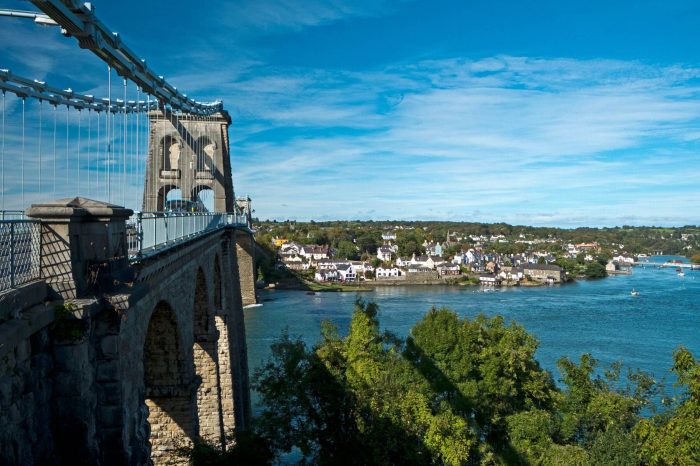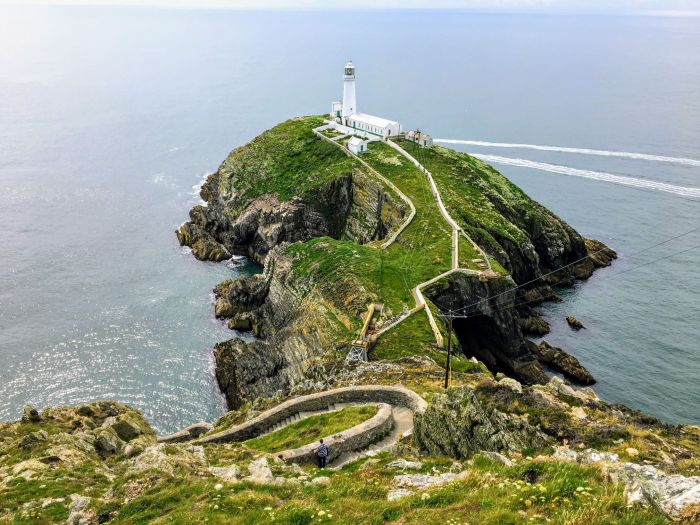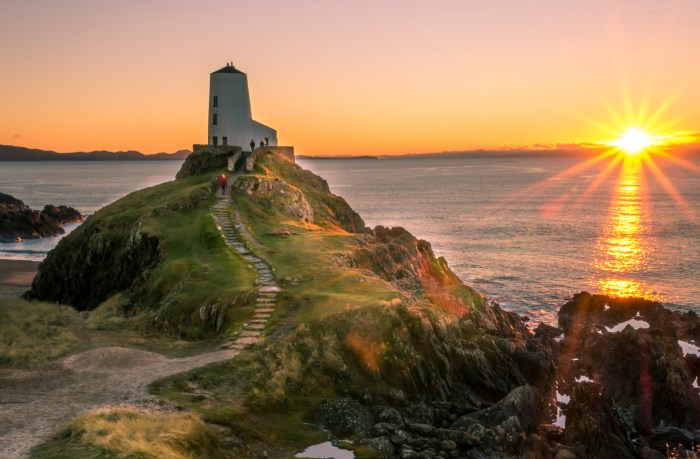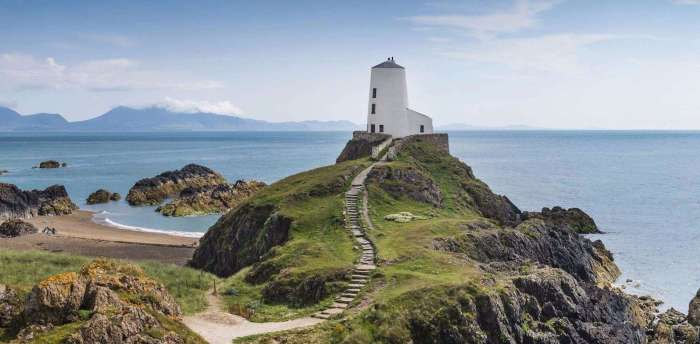Anglesey, a picturesque island off the coast of North Wales, beckons travelers with its captivating history, stunning geography, and vibrant culture. From its ancient Celtic roots to its modern-day charm, Anglesey offers a rich tapestry of experiences that will enchant and inspire.
With its rugged coastline, rolling hills, and tranquil waterways, Anglesey is a haven for nature enthusiasts and outdoor adventurers alike. The island’s rich cultural heritage, evident in its language, traditions, and folklore, adds a unique dimension to its allure.
History of Anglesey
Anglesey, an island off the northwest coast of Wales, boasts a rich and captivating history. Its origins can be traced back to the Neolithic era, with evidence of human habitation dating back over 6,000 years. The island has played a pivotal role in Welsh and British history, serving as a stronghold for Celtic tribes, a Roman outpost, and a Viking settlement.
Anglesey, a picturesque island off the coast of Wales, boasts an array of natural wonders and historical sites. Its rich heritage extends to UNESCO World Heritage Sites, such as the awe-inspiring UNESCO World Heritage Sites. The island’s ancient monuments, including the majestic Beaumaris Castle, stand as testaments to its intriguing past.
Anglesey’s unique blend of culture and nature continues to captivate visitors from far and wide.
Celtic Era
During the Celtic era, Anglesey was known as Môn and was inhabited by the Celts, who established their culture and traditions on the island. The Celts were known for their druidic practices, and Anglesey was considered a sacred island, home to a major druidic center.
Roman Conquest
In 60 AD, the Roman Empire invaded Anglesey, seeking to subdue the Celtic tribes. The Romans established a military outpost on the island, which became a strategic base for their operations in Wales. The Roman presence on Anglesey lasted for over 300 years, leaving behind a legacy of roads, forts, and other structures.
Viking Invasions
In the 9th century, Anglesey was subjected to repeated Viking raids. The Vikings established a settlement on the island, which became a base for their raids on mainland Wales. The Viking presence on Anglesey lasted for over a century, leaving behind a lasting impact on the island’s culture and language.
Norman Conquest
In 1066, the Normans invaded England, and their influence soon spread to Wales. Anglesey was conquered by the Normans in 1098, and the island became part of the Norman earldom of Chester. The Normans introduced a feudal system to Anglesey, which had a profound impact on the island’s social and economic structure.
Welsh Resistance
Throughout the Middle Ages, the Welsh people resisted Norman rule, and Anglesey became a stronghold for Welsh resistance. In the 13th century, the Welsh prince Llywelyn the Great seized control of Anglesey, and the island became part of the independent Welsh kingdom of Gwynedd.
English Conquest
In 1282, Edward I of England invaded Wales and conquered Anglesey. The island became part of the English kingdom, and the Welsh resistance was gradually suppressed. Anglesey remained under English rule for over 600 years, during which time it experienced significant economic and social changes.
Anglesey, a captivating island off the coast of Wales, is a haven of natural beauty and rich history. With its stunning beaches, picturesque landscapes, and ancient landmarks, it’s no wonder that it has been recognized as one of the best travel destinations for 2024.
From exploring the medieval Beaumaris Castle to discovering the hidden coves along the coastal path, Anglesey offers an unforgettable experience for every traveler.
Modern Era
In the 20th century, Anglesey underwent a period of industrialization, with the development of copper mining and other industries. The island also became a popular tourist destination, known for its beautiful scenery and rich history. Today, Anglesey is a thriving community with a diverse economy and a strong sense of Welsh identity.
Geography of Anglesey

Anglesey is an island off the northwest coast of Wales, separated from the mainland by the Menai Strait. It is the largest island in Wales and the seventh largest in the UK, with an area of 276 square miles (716 square kilometers).
The island has a diverse landscape, with a rugged coastline, rolling hills, and fertile valleys. The coastline is dotted with sandy beaches, rocky cliffs, and sheltered coves. The highest point on the island is Holyhead Mountain, which rises to 720 feet (220 meters) above sea level.
Mountains
Anglesey is home to a number of mountains, including:
- Holyhead Mountain (720 feet)
- Mynydd Bodafon (584 feet)
- Mynydd Twr (549 feet)
- Mynydd y Garn (469 feet)
Rivers
Anglesey is drained by a number of rivers, including:
- The Afon Alaw
- The Afon Braint
- The Afon Cefni
- The Afon Goch
Geological Features
Anglesey has a number of unique geological features, including:
- The Parys Mountain copper mine
- The South Stack Lighthouse
- The Giant’s Causeway
- The Newborough Warren
The Parys Mountain copper mine was once one of the largest copper mines in the world. The South Stack Lighthouse is a famous landmark that stands on a rocky outcrop off the coast of Holyhead. The Giant’s Causeway is a natural rock formation that consists of hexagonal basalt columns. The Newborough Warren is a large sand dune system that is home to a variety of wildlife.
Culture and Heritage of Anglesey

Anglesey, a captivating isle in the Irish Sea, boasts a rich cultural heritage that has been shaped by its unique history and geographical isolation. From its ancient Celtic roots to its vibrant present, Anglesey’s culture is a tapestry of traditions, folklore, and artistic expressions.
The island’s language, Welsh, has been an integral part of its cultural identity for centuries. Welsh is spoken by a majority of the population and is actively promoted through education and community initiatives. The island’s rich oral tradition has been passed down through generations, with tales of mythical creatures, legendary heroes, and ancient battles captivating listeners.
Anglesey, an island off the coast of Wales, is steeped in ancient history and Celtic culture. To delve deeper into Europe’s rich heritage, consider embarking on cultural tours in Europe. These tours offer immersive experiences that showcase the diverse traditions, art, and architecture of the continent.
While Anglesey provides a glimpse into Welsh culture, a broader European tour expands your cultural horizons, allowing you to explore the interconnectedness of our shared history.
Artistic and Literary Contributions
Anglesey has produced notable artists and writers who have made significant contributions to Welsh and international culture. The renowned sculptor Sir Kyffin Williams, known for his evocative landscapes, was born and raised on the island. Other notable artists include the painter Charles Tunnicliffe and the printmaker John Piper, both of whom found inspiration in Anglesey’s natural beauty.
The island has also been a source of inspiration for literary works. The Welsh poet R.S. Thomas, who spent much of his life on Anglesey, explored themes of faith, nature, and the human condition in his evocative poetry. Other writers associated with Anglesey include the novelist Emyr Humphreys and the playwright Gwyn Thomas.
Economy and Tourism of Anglesey

Anglesey’s economy is primarily driven by agriculture, tourism, and renewable energy. The island’s fertile soils support a thriving agricultural sector, with sheep farming being the most significant industry. Anglesey is also home to a number of dairy and beef farms, as well as a growing aquaculture industry.
Tourism, Anglesey
Tourism is a major contributor to the island’s economy. Anglesey’s stunning coastline, historic landmarks, and natural beauty attract a large number of visitors each year. The island is home to several popular tourist destinations, including the Menai Suspension Bridge, Beaumaris Castle, and South Stack Lighthouse.
The impact of tourism on Anglesey’s economy is significant. The industry provides employment for a large number of people, and it also supports a number of local businesses. However, tourism can also have a negative impact on the island’s culture and environment.
Renewable Energy
Anglesey is a leader in the field of renewable energy. The island is home to a number of wind farms, and it is also a major producer of solar energy. Anglesey’s commitment to renewable energy is helping to reduce the island’s carbon footprint and create a more sustainable future.
Notable Landmarks and Attractions of Anglesey

Anglesey, an island off the coast of Wales, boasts an array of captivating landmarks and attractions that draw visitors from far and wide. From ancient historical sites to natural wonders, the island offers a rich tapestry of experiences for travelers.
Beaumaris Castle
Beaumaris Castle, a magnificent medieval fortress, stands as a testament to the island’s turbulent past. Constructed by King Edward I in the 13th century, the castle was intended as a symbol of English power in Wales. Its concentric walls, imposing towers, and grand gatehouse showcase the architectural prowess of its time. Today, visitors can explore the castle’s ruins, marveling at its intricate details and learning about its historical significance.
South Stack Lighthouse
Perched on a dramatic headland on the island’s western coast, South Stack Lighthouse is an iconic landmark. Built in 1809, the lighthouse guides ships through the treacherous waters of the Irish Sea. Visitors can climb to the top of the lighthouse for breathtaking panoramic views of the surrounding coastline and seabird colonies.
Llanddwyn Island
Llanddwyn Island, a small tidal island connected to Anglesey by a causeway, is a place of historical and spiritual significance. The island is home to the ruins of a 12th-century church, believed to have been founded by Saint Dwynwen, the patron saint of Welsh lovers. Visitors can explore the island’s sandy beaches, admire the views of Snowdonia, and learn about its rich history.
Menai Suspension Bridge
The Menai Suspension Bridge, an engineering marvel of the 19th century, spans the Menai Strait connecting Anglesey to mainland Wales. Designed by Thomas Telford, the bridge was completed in 1826 and remains one of the most iconic landmarks in Wales. Visitors can cross the bridge by car or on foot, admiring its graceful arches and the stunning views of the surrounding landscape.
Snowdonia National Park
While not exclusively located on Anglesey, Snowdonia National Park is easily accessible from the island and offers a wealth of natural beauty. The park is home to Snowdon, the highest mountain in Wales, as well as numerous other peaks, lakes, and valleys. Visitors can enjoy hiking, climbing, biking, and other outdoor activities amidst the park’s breathtaking scenery.
Transportation and Accessibility of Anglesey

Anglesey is a well-connected island with various transportation options, making it easily accessible from mainland Wales and other parts of the United Kingdom.
The island’s primary link to the mainland is the Menai Suspension Bridge, a historic structure carrying the A5 road. This bridge connects Anglesey to the city of Bangor in Gwynedd, providing a convenient route for vehicles and pedestrians. Additionally, the Britannia Bridge, located further east, carries the A55 expressway and provides an alternative crossing point.
Roadways and Public Transportation
Anglesey has a well-developed road network that connects its major towns and villages. The A5 and A55 roads serve as the main arteries, providing access to the island’s interior and coastal areas. Local bus services operate throughout Anglesey, connecting towns and providing links to the mainland.
Railways
While Anglesey does not have its own railway network, it is served by the North Wales Coast Line, which runs along the island’s northern coast. This line provides connections to major cities such as Bangor, Llandudno, and Holyhead, which offers ferry services to Ireland.
Air Travel
Anglesey Airport (EGOV) is located in the center of the island and offers a limited number of flights to destinations within the United Kingdom. However, the nearest major airport with international connections is Liverpool John Lennon Airport (LPL), which is approximately an hour’s drive from Anglesey.
Ferries
Anglesey is connected to Ireland via ferry services from Holyhead Port, the island’s main port. These ferries provide regular crossings to Dublin and other Irish destinations, making Anglesey a convenient gateway to Ireland.
Accommodation and Dining Options on Anglesey
Anglesey offers a range of accommodation options to suit all tastes and budgets. From cozy guesthouses to luxurious hotels, there’s something for everyone. Many of the accommodations are located near the island’s stunning beaches, offering breathtaking views of the coastline.
The island is also home to a variety of restaurants, serving everything from traditional Welsh cuisine to international fare. Whether you’re looking for a romantic dinner or a casual bite to eat, you’ll be sure to find something to your liking.
Hotels
Anglesey is home to several hotels, ranging from budget-friendly options to upscale resorts. Many of the hotels offer stunning views of the sea or the mountains. Some of the most popular hotels on the island include:
- The Bull Hotel in Beaumaris
- The Tre-Ysgawen Hall Hotel in Tre-Ysgawen
- The Beach Hotel in Rhosneigr
Guesthouses
Guesthouses are a great option for those looking for a more personal and intimate experience. Many guesthouses on Anglesey are family-run and offer a warm and welcoming atmosphere. Some of the most popular guesthouses on the island include:
- The Anglesey Arms in Menai Bridge
- The Bryn-y-Mor Guest House in Benllech
- The Plas Rhianfa Guest House in Beaumaris
Restaurants
Anglesey has a wide variety of restaurants, serving everything from traditional Welsh cuisine to international fare. Some of the most popular restaurants on the island include:
- The Marram Grass in Newborough
- The Oyster Catcher in Moelfre
- The Beachcomber in Rhosneigr
Local Cuisine
Anglesey is known for its fresh seafood, including mussels, oysters, and crab. The island is also home to several award-winning cheesemakers. Some of the most popular local dishes include:
- Welsh lamb
- Anglesey mussels
- Bara brith (Welsh fruit bread)
Events and Activities on Anglesey

Anglesey is a vibrant island with a diverse range of events and activities taking place throughout the year. From lively festivals and music concerts to thrilling sporting events and cultural exhibitions, there’s something for everyone to enjoy on Anglesey.
Festivals
Anglesey hosts several popular festivals throughout the year, each offering a unique blend of music, culture, and local traditions. Some of the most notable festivals include:
- Anglesey Food Festival: Held annually in September, this festival celebrates the island’s culinary delights with a showcase of local produce, cooking demonstrations, and live music.
- Menai Bridge Victorian Festival: Step back in time at this charming festival, held every August in the picturesque town of Menai Bridge. The festival features Victorian-themed activities, costumes, and a lively street market.
- Beaumaris Music Festival: This annual festival takes place in June and features a diverse lineup of classical, jazz, and folk music performances held in various venues around the town of Beaumaris.
Final Conclusion

Whether you seek historical exploration, breathtaking landscapes, or cultural immersion, Anglesey promises an unforgettable journey. Its diverse attractions, from ancient landmarks to contemporary art galleries, cater to every taste and interest. As you delve into the island’s secrets, you will discover a land where history, nature, and culture harmoniously intertwine.
Q&A
What is Anglesey known for?
Anglesey is renowned for its historical significance, stunning natural beauty, and rich cultural heritage.
How do I get to Anglesey?
Anglesey is accessible by car via the Menai Suspension Bridge or by train to Holyhead.
What are the must-visit attractions on Anglesey?
Anglesey boasts numerous attractions, including Beaumaris Castle, South Stack Lighthouse, and the Anglesey Coastal Path.
What is the best time to visit Anglesey?
Anglesey is a year-round destination, but spring and summer offer the most pleasant weather for outdoor activities.